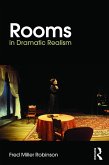The book investigates:
- Roman comedy and Shakespearean dramas in which the stage-space itself constituted the primary scenographic element and actors' bodies shaped the playing space more than did sets or props
- the use of paid applauders in nineteenth-century Parisian theaters and how this practice reconfigured theatrical space
- transactions between stage designers and spectators, including work by László Moholy-Nagy, William Ritman, and Eiko Ishioka
Dramatic Spaces aims to do for stage design what reader-response criticism has done for the literary text, with specific case studies on Coriolanus, The Comedy of Errors, Romeo and Juliet, Tales of Hoffman, M. Butterfly and Tiny Alice exploring the audience's contribution to the construction of meaning.
Dieser Download kann aus rechtlichen Gründen nur mit Rechnungsadresse in A, B, BG, CY, CZ, D, DK, EW, E, FIN, F, GR, HR, H, IRL, I, LT, L, LR, M, NL, PL, P, R, S, SLO, SK ausgeliefert werden.









